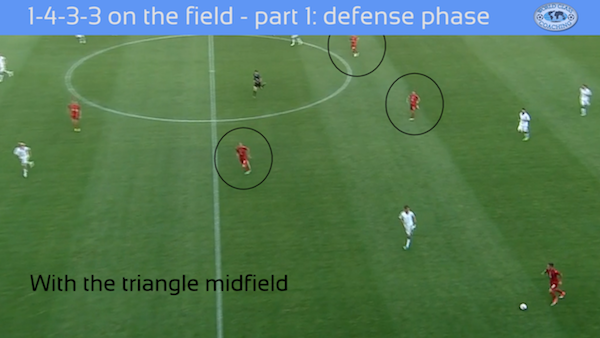WORLD CLASS COACHING
A Quick Guide to the 1-4-3-3
By Luca Bertolini
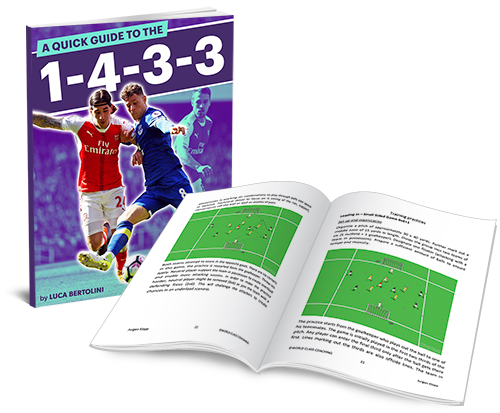
TABLE OF CONTENTS
Part One
INTRODUCTION
THE DEFENSIVE PHASE
Part Two
HOW TO COACH THE 1-4-3-3 DEFENDING
DEFENSIVE EXERCISES
DEFENSIVE SMALL-SIDED GAMES
Part Three
THE ATTACKING PHASE
Part Four
HOW TO COACH THE 1-4-3-3 ATTACKING
ATTACKING EXERCISES
ATTACKING SMALL-SIDED GAMES
Introduction
In this e-book we are going to analyze a possible development of the 1-4-3-3 system of play, one of the most known, most important, most used and coached way of giving shape to soccer teams on the field, all over the world.
For this reason this e-book doesn't aim to be an ultimate overview; the goal is to underline how the principles of play of a team are carried out on the field. It is going to analyze the 1-4-3-3 basic formation during the defensive phases of play in the first part and during the possession and attacking phases of play in the second part.
In this following picture, the classic basic 1-4-3-3 formation is shaped on the pitch: a line of four defenders, a triangle midfield and the last line of three forwards.

If we would have to summarize with few words the classic situations of this system of play we may divide the players and the roles on the pitch into three parts.
The four defenders often play like they would in the 1-4-4-2, with zonal defending during the non-possession phases and running forward to support the attacking moves during the side by side play in the middle third during the building phases when the team is in possession. In recent seasons, man-marking is coming back as an important principle of play as the speed of the moves and the intensity of the rhythm of play are getting faster.
They still play as a block to cover the width of the field and close off spaces where attackers could run in, but as the ball is lost, the distances among defenders and the forwards are very short and the old order of the defenders on the same line or on two lines is not used anymore by now.
The three midfielders usually play in a triangle shape and the center midfielder can be a lower or upper vertex for the other two midfielders; usually he is a center playmaker just few yards away from the defense line. The midfield block plays and is usually placed as near as possible to the ball in the middle third and the opposite outside forward must cover the space of the weak side if a move is being carried out along the side lines.
Usually the outer forwards create a line of five in the middle third when the possession of the ball is lost and it's not possible to put pressure.
One of the midfielders can be often unmarked in the space to receive the ball, both if there is a defensive triangle or an offensive triangle shape on the field.
The center forwards are usually the ones of the three who don't run back and stay placed as high as possible to be an option as the ball is recovered. The outside forwards are the players with the hardest role, together with the midfielders; they must cover the spaces to avoid the creation of dangerous moves of the opposition in the middle third, if the midfielders would have to run out of their position and, at the same time, they must always support the side by side play and the attacking moves.
If the developments on the field of this system of play must be looked for, the main all- pervading principles of play that the team wants to carry out must be found out, first of all. In this e-book they are:
• the numerical advantage near the ball and against the opponent in possession• different defending shapes depending on the third of the field to be saved
• a clear division of the team among attacking players and defending players during the possession phases of play
• to be sure of preventively man-marking and of saving the spaces, if the ball is lost
Nowadays, soccer, after Guardiola's Barcelona seasons I would say, is based more on principles of play rather than on the player's role inside a formation on the field."I am very good in placing the players on the field, but it's a pity because then they move and run while playing," I read somewhere.
I think that in the following pages it will be clearly shown that the 1-4-3-3 system of play and its developments on the field are created as a consequence of the principles of play of the team we are going to analyze and not vice versa.


In this first defensive situation, the six advanced players (the three forwards and the three midfielders) are the first defenders during a negative transition, and they try to put pressure in numerical advantage (2 v 1) against the opponent in possession; one of the center midfielders is defending together with the center forward who dropped back.

This is clearly a double marking principle of play during the negative transition phases, as the same situation can be found both in the middle third and in the final third when the possession is lost; it doesn't matter if it is during a building up phase, a side by side phase of play, or a finishing phase.

When the double marking is not possible, the first goal is to play immediate 1 v 1 counter-pressing, if the move is being carried out in the final third, to force the possession phase of the opposition and to close the forward pass lanes.

If the whole team must stay placed in the defending half, the three forwards (or at least two of them) have to create numerical advantage on the ball while the midfielders close the pass lanes and save the last defense line of four.

If the forwards are able to force the direction of the opposition build up phase, the six advanced players come back to put strong pressure to win the possession or to end the move anyway.

In this move two of the three forwards disturbed and forced the direction of the opposition's build up phase of play toward the goalkeeper, who then has to kick the ball away because of the pressure.

In this way, the midfield line can close forward pass lanes and stay away from the defense third, forcing again backward the opposition possession phase.

In this move it is very useful to notice how the high pressure is overcome by the opposition, who can play forward on the field. The first basic 1-4-3-3 develops in a classic 1-4-5 defensive formation in the final third, but with the midfield line which is organized with a 4+1, as the fifth player is running back after a double marking attempt.

The midfield line is basically made of three players, but it can be shaped also with four players if one opponent tries to run without the ball to cut the line out; in this case the outside forward runs back to cover the flank and the center midfielder marks the opponent on, or the forward follows him directly. The main objective is, again, to create a numerical advantage on the ball as soon as possible.

These following pictures are very interesting because they show what we were talking about in the introduction; the basic formation of a team is a consequence of the principles of play and not vice versa. In this first picture, the team seems to be unshaped and nearly unbalanced, but a 3 v 2 situation on the ball is very clear.

In this second situation, two of the three midfielders are close to the opponent in possession to send him backward, playing 2 v 1, the third one is getting closer, and the two outside forwards dropped back to shape a line of five in the middle third. To force the direction of play is more important than the risk of creating space; thus, the line of five and the line of four defenders are placed high.

Again the team seems to be unshaped and nearly unbalanced during another move, but a 2 v 1 situation on the ball is very clear and all the opponents are marked. The opposition must play backwards.

In this next move, the team is better 4-3-3 shaped, even larger on the field, but the forwards follow the basic defense principle of play: create numerical advantage (2 v 1) against the opponent in possession, playing closer to each other.

The same principle of play is followed and developed in the final third; 2 v 1 numerical advantage is on the ball and all the other defense players are potentially able to double mark another recipient of a pass among all the opponents.

The defensive principle of play is very clear from this sequential throw-in situation; a very strong side is created as well as an immediate numerical advantage against the first receiver.

If the possession is not recovered, the strong side is maintained near the ball until the opponent must play back to build up again...

...and the team positions on the pitch in a starting 4-3-3 formation with the lines close to one another if there's no chance of pressure.

But whatever are the developments of a move, at least a 2 v 1 situation is created again as a double marking chance is possible and as the opposition play by play can be forced backwards.
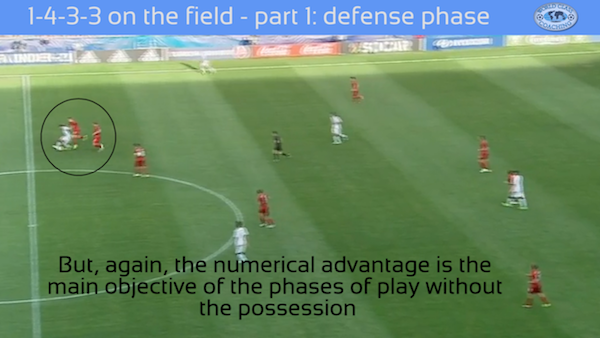
If the midfield line is cut off, for instance after a rebounds phase of play, the defensive tactical idea is to create numerical advantage near the most dangerous parts of the field, even conceding a potential cross pass through a 1 v 1 duel. Being sure to mark the opposition with the highest number of players possible inside the box and to have a double marking chance, as the player in possession is getting closer to the penalty area are more important principles of play.
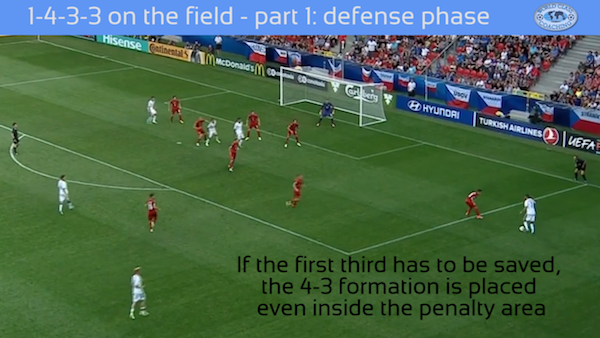
If the midfield line is on late against the build up or the attacking phases of the opposition, a line of 5 players is created in the middle third to ensure the numerical advantage on the ball in the center, as well as on the flanks, if the opposition tries to play wide. If possible, the defense forces a back pass and can run up on the field.
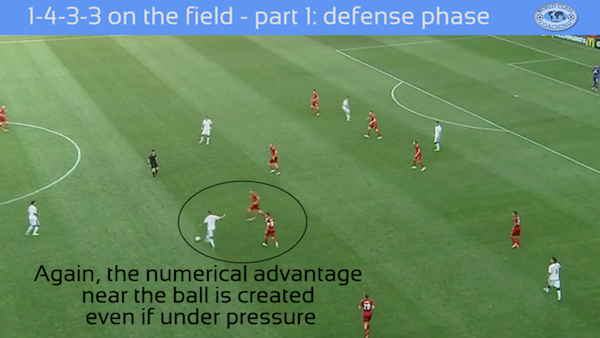
In this situation, as the opposition attacks with the same kind of tactic, 3+3, the defensive formation becomes 1-4-1-4, with the center player who is placed just few yards away from the defense line, the other two center midfielders very close to each other and to him. The outside forwards play as wingers to create a line of four. This way the double marking on the opposition is easier all over the playing area.
As the direction of play is then sent backward, the center player and the left one (depending on the side of play) run up to play with a temporary 1-4-4-2 formation.
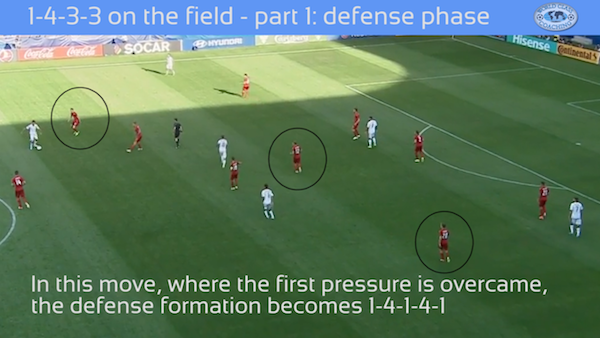
This last is developed again as a 4 v 3 situation of defense; numerical advantage is created again on the flank as the ball is lost during the positive transition, even through an unbalanced defensive shape.
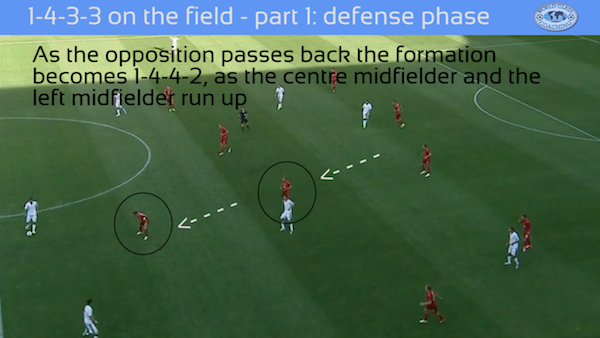
Here again a 1-4-1-4 formation is shaped to save the final third, to ensure numerical advantage against the opponent with the ball and against all the potential receivers...
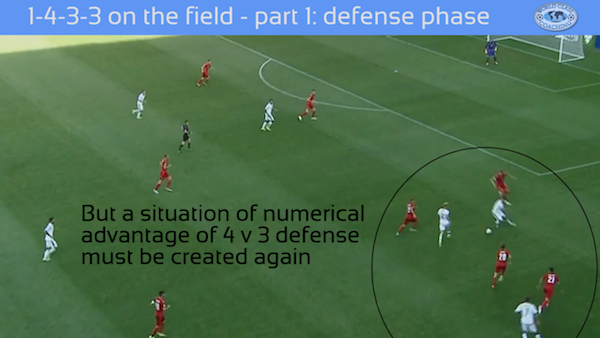
...but it develops into a 1-5-2-2 formation to ensure, again, the numerical advantage (2 v 1) against four opposition's forwards and to force the direction of play toward the side line.
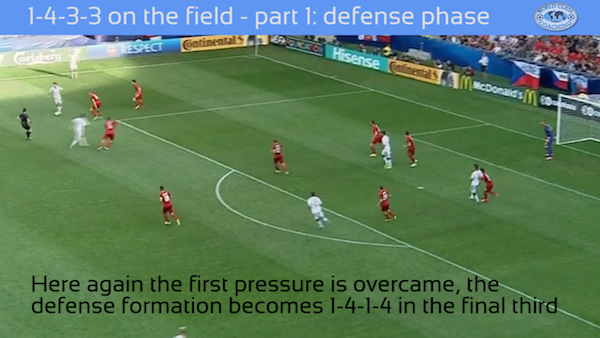
It's very interesting to look at the defensive move here; the midfield line is cut off and the center back marks the man on, following him toward the side line and waiting for a double marking of team mate, while the center midfielders cover his position. Here again there is a 1-5-2-2 defensive formation near the penalty area.
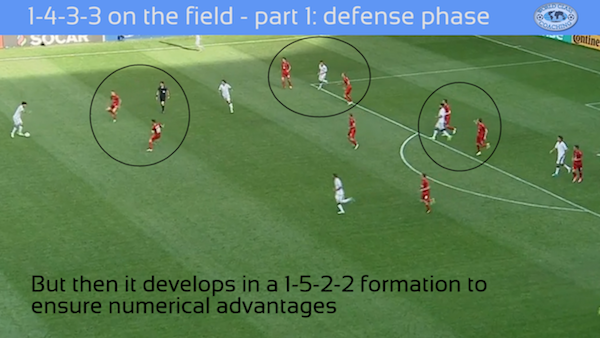
As the possession is gained back, the formation on the field develops during the transition to attack phase, and it becomes a triangle midfield with three forwards ready to attack the deep spaces forward...
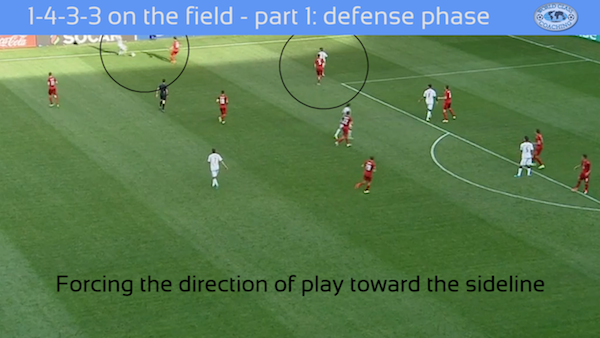
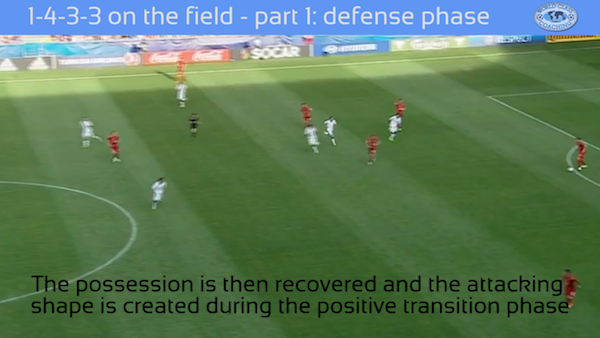
...and the three forwards are placed along the whole width of the field ready to receive or to run inside toward the center.
